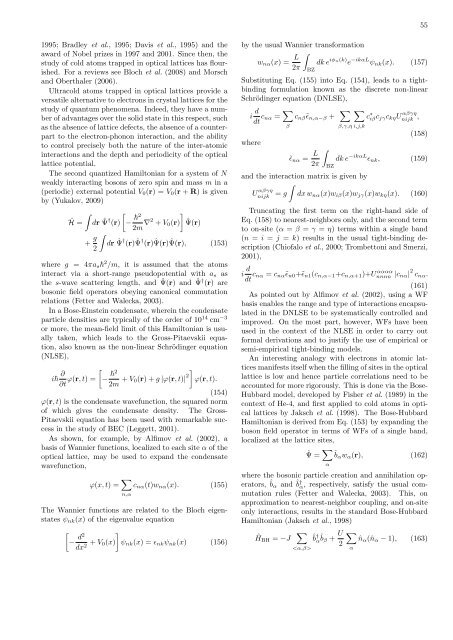Maximally localized Wannier functions: Theory and applications
Maximally localized Wannier functions: Theory and applications
Maximally localized Wannier functions: Theory and applications
You also want an ePaper? Increase the reach of your titles
YUMPU automatically turns print PDFs into web optimized ePapers that Google loves.
55<br />
1995; Bradley et al., 1995; Davis et al., 1995) <strong>and</strong> the<br />
award of Nobel prizes in 1997 <strong>and</strong> 2001. Since then, the<br />
study of cold atoms trapped in optical lattices has flourished.<br />
For a reviews see Bloch et al. (2008) <strong>and</strong> Morsch<br />
<strong>and</strong> Oberthaler (2006).<br />
Ultracold atoms trapped in optical lattices provide a<br />
versatile alternative to electrons in crystal lattices for the<br />
study of quantum phenomena. Indeed, they have a number<br />
of advantages over the solid state in this respect, such<br />
as the absence of lattice defects, the absence of a counterpart<br />
to the electron-phonon interaction, <strong>and</strong> the ability<br />
to control precisely both the nature of the inter-atomic<br />
interactions <strong>and</strong> the depth <strong>and</strong> periodicity of the optical<br />
lattice potential.<br />
The second quantized Hamiltonian for a system of N<br />
weakly interacting bosons of zero spin <strong>and</strong> mass m in a<br />
(periodic) external potential V 0 (r) = V 0 (r + R) is given<br />
by (Yukalov, 2009)<br />
∫<br />
Ĥ =<br />
dr ˆΨ † (r)<br />
[− ħ2<br />
∫<br />
+ g 2<br />
]<br />
2m ∇2 + V 0 (r) ˆΨ(r)<br />
dr ˆΨ † (r) ˆΨ † (r) ˆΨ(r) ˆΨ(r), (153)<br />
where g = 4πa s ħ 2 /m, it is assumed that the atoms<br />
interact via a short-range pseudopotential with a s as<br />
the s-wave scattering length, <strong>and</strong> ˆΨ(r) <strong>and</strong> ˆΨ † (r) are<br />
bosonic field operators obeying canonical commutation<br />
relations (Fetter <strong>and</strong> Walecka, 2003).<br />
In a Bose-Einstein condensate, wherein the condensate<br />
particle densities are typically of the order of 10 14 cm −3<br />
or more, the mean-field limit of this Hamiltonian is usually<br />
taken, which leads to the Gross-Pitaevskii equation,<br />
also known as the non-linear Schrödinger equation<br />
(NLSE),<br />
iħ ∂ [<br />
]<br />
∂t φ(r, t) = − ħ2<br />
2m + V 0(r) + g |φ(r, t)| 2 φ(r, t).<br />
(154)<br />
φ(r, t) is the condensate wavefunction, the squared norm<br />
of which gives the condensate density. The Gross-<br />
Pitaevskii equation has been used with remarkable success<br />
in the study of BEC (Leggett, 2001).<br />
As shown, for example, by Alfimov et al. (2002), a<br />
basis of <strong>Wannier</strong> <strong>functions</strong>, <strong>localized</strong> to each site α of the<br />
optical lattice, may be used to exp<strong>and</strong> the condensate<br />
wavefunction,<br />
φ(x, t) = ∑ n,α<br />
c nα (t)w nα (x). (155)<br />
The <strong>Wannier</strong> <strong>functions</strong> are related to the Bloch eigenstates<br />
ψ nk (x) of the eigenvalue equation<br />
]<br />
[− d2<br />
dx 2 + V 0(x) ψ nk (x) = ϵ nk ψ nk (x) (156)<br />
by the usual <strong>Wannier</strong> transformation<br />
w nα (x) = L ∫<br />
dk e iϕn(k) e −ikαL ψ nk (x). (157)<br />
2π<br />
BZ<br />
Substituting Eq. (155) into Eq. (154), leads to a tightbinding<br />
formulation known as the discrete non-linear<br />
Schrödinger equation (DNLSE),<br />
i d dt c nα = ∑ β<br />
where<br />
c nβ˜ϵ n,α−β + ∑ β,γ,η<br />
˜ϵ nα = L 2π<br />
∫<br />
BZ<br />
∑<br />
i,j,k<br />
c ∗ iβc jγ c kη U αβγη<br />
nijk ,<br />
(158)<br />
dk e −ikαL ϵ nk , (159)<br />
<strong>and</strong> the interaction matrix is given by<br />
∫<br />
= g dx w nα (x)w iβ (x)w jγ (x)w kη (x). (160)<br />
U αβγη<br />
nijk<br />
Truncating the first term on the right-h<strong>and</strong> side of<br />
Eq. (158) to nearest-neighbors only, <strong>and</strong> the second term<br />
to on-site (α = β = γ = η) terms within a single b<strong>and</strong><br />
(n = i = j = k) results in the usual tight-binding description<br />
(Chiofalo et al., 2000; Trombettoni <strong>and</strong> Smerzi,<br />
2001),<br />
i d dt c nα = c nα˜ϵ n0 +˜ϵ n1 (c n,α−1 +c n,α+1 )+Unnnn αααα |c nα | 2 c nα .<br />
(161)<br />
As pointed out by Alfimov et al. (2002), using a WF<br />
basis enables the range <strong>and</strong> type of interactions encapsulated<br />
in the DNLSE to be systematically controlled <strong>and</strong><br />
improved. On the most part, however, WFs have been<br />
used in the context of the NLSE in order to carry out<br />
formal derivations <strong>and</strong> to justify the use of empirical or<br />
semi-empirical tight-binding models.<br />
An interesting analogy with electrons in atomic lattices<br />
manifests itself when the filling of sites in the optical<br />
lattice is low <strong>and</strong> hence particle correlations need to be<br />
accounted for more rigorously. This is done via the Bose-<br />
Hubbard model, developed by Fisher et al. (1989) in the<br />
context of He-4, <strong>and</strong> first applied to cold atoms in optical<br />
lattices by Jaksch et al. (1998). The Bose-Hubbard<br />
Hamiltonian is derived from Eq. (153) by exp<strong>and</strong>ing the<br />
boson field operator in terms of WFs of a single b<strong>and</strong>,<br />
<strong>localized</strong> at the lattice sites,<br />
ˆΨ = ∑ α<br />
ˆbα w α (r), (162)<br />
where the bosonic particle creation <strong>and</strong> annihilation operators,<br />
ˆb α <strong>and</strong> ˆb † α, respectively, satisfy the usual commutation<br />
rules (Fetter <strong>and</strong> Walecka, 2003). This, on<br />
approximation to nearest-neighbor coupling, <strong>and</strong> on-site<br />
only interactions, results in the st<strong>and</strong>ard Bose-Hubbard<br />
Hamiltonian (Jaksch et al., 1998)<br />
Ĥ BH = −J<br />
∑ ˆb† αˆbβ + U ∑<br />
ˆn α (ˆn α − 1), (163)<br />
2<br />
<br />
α













